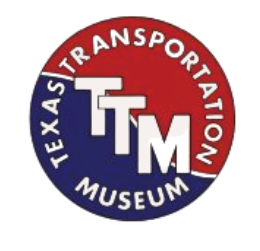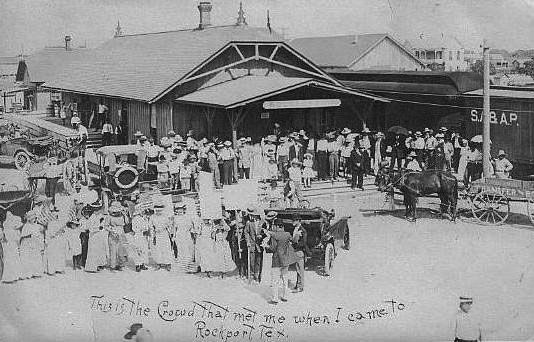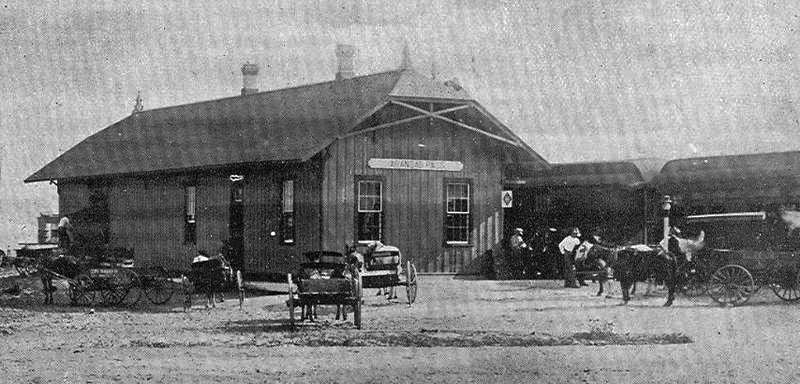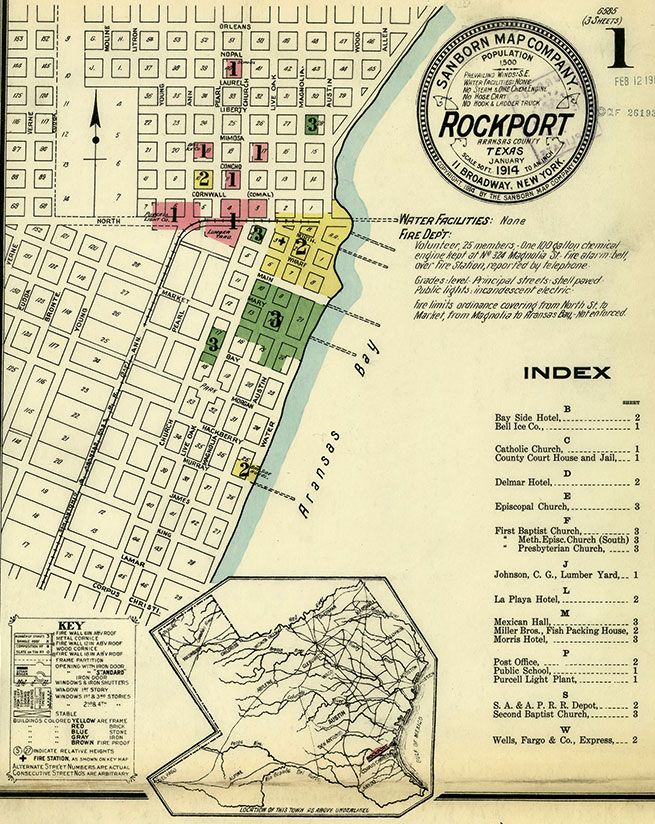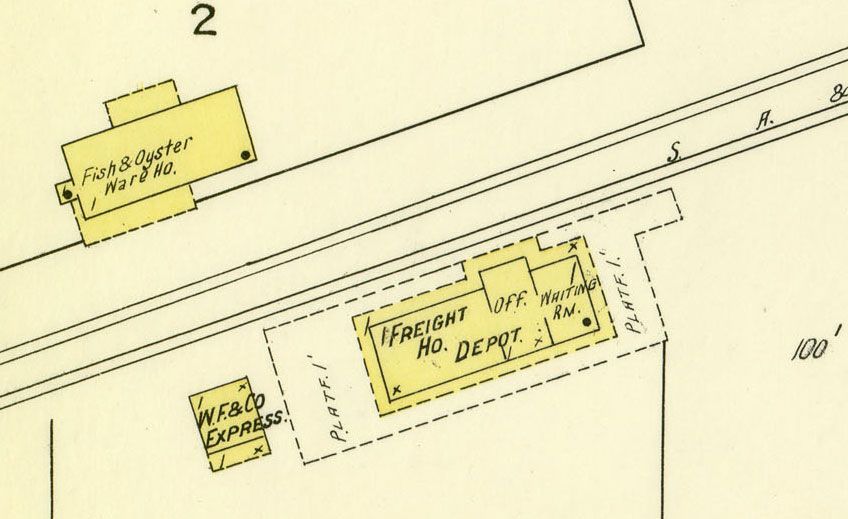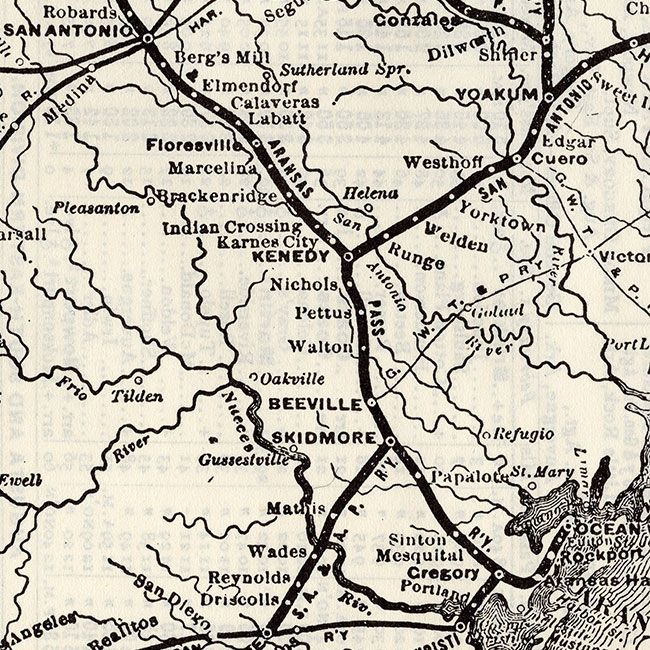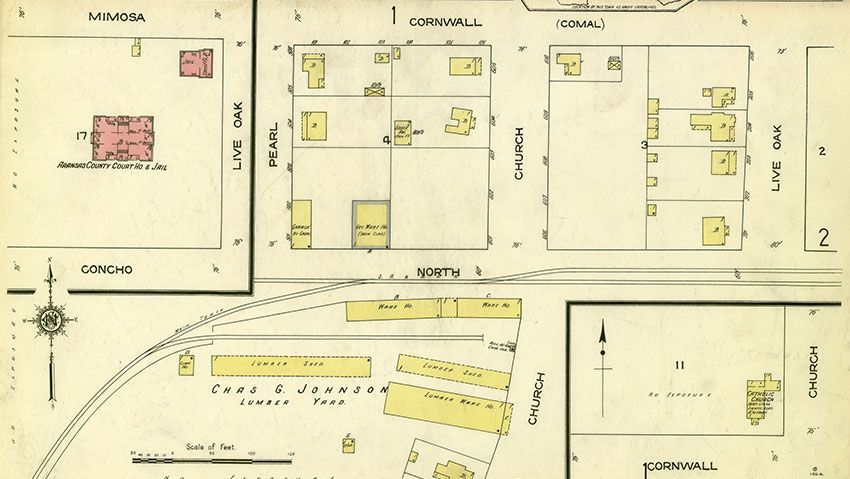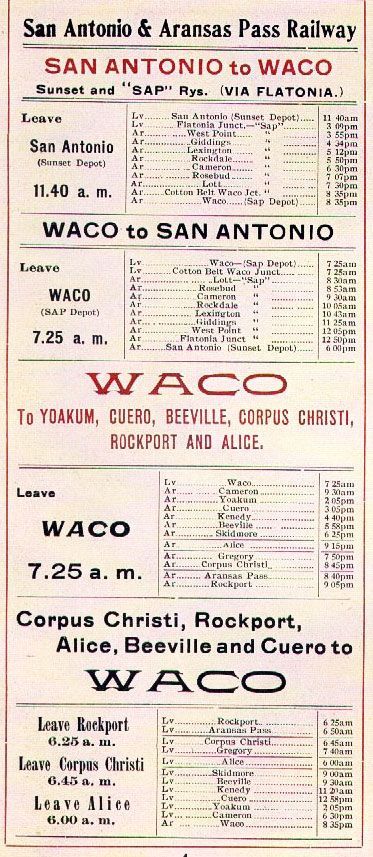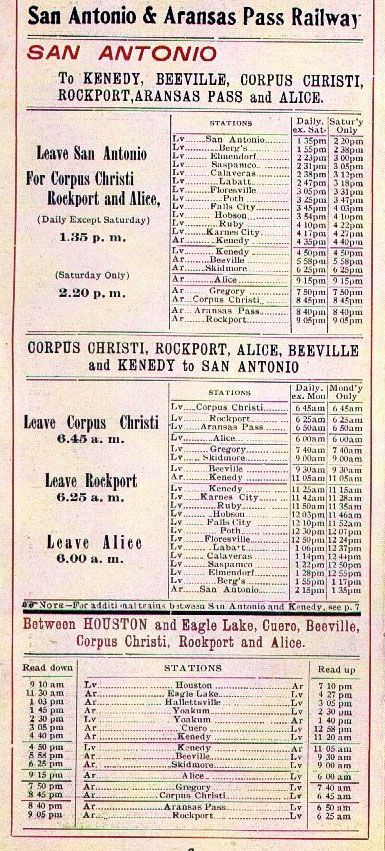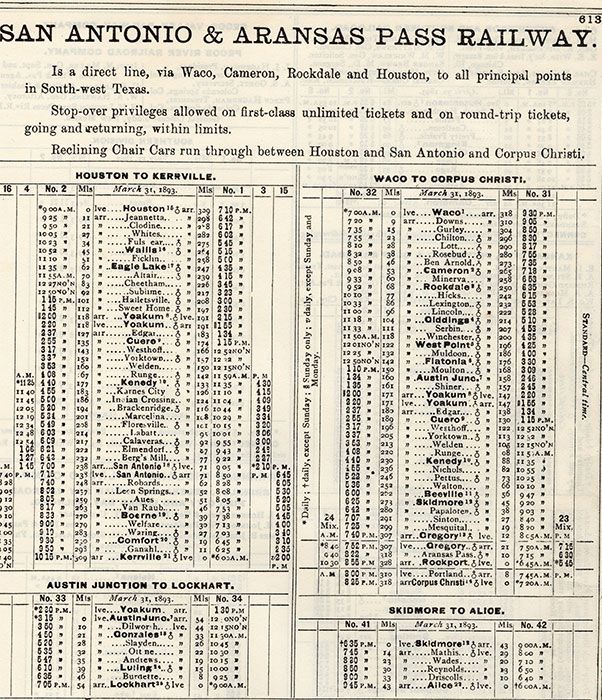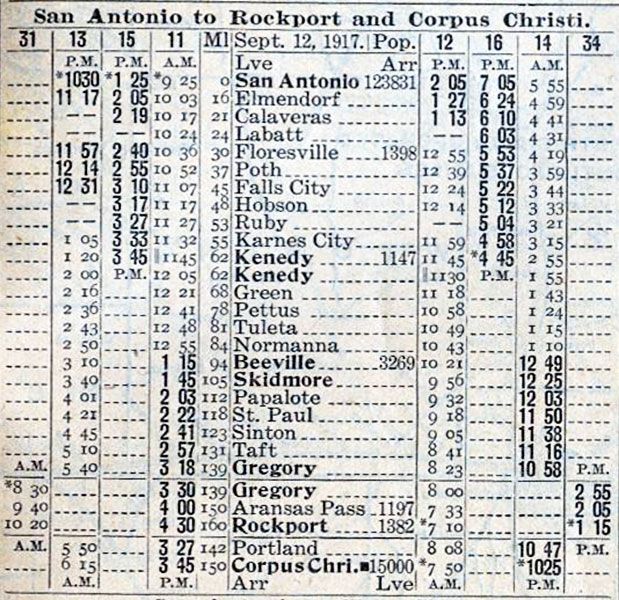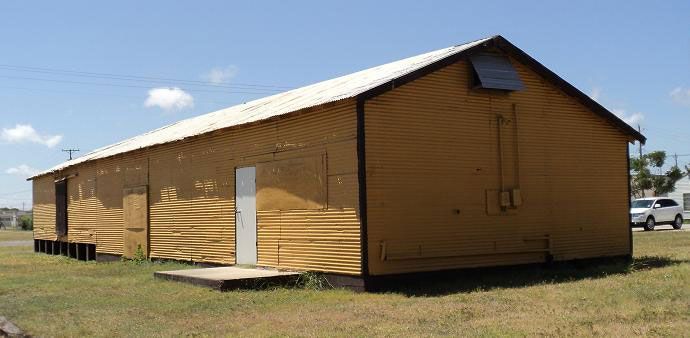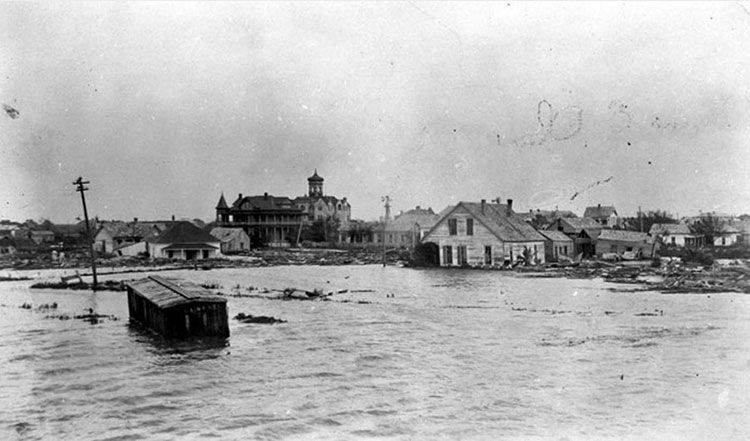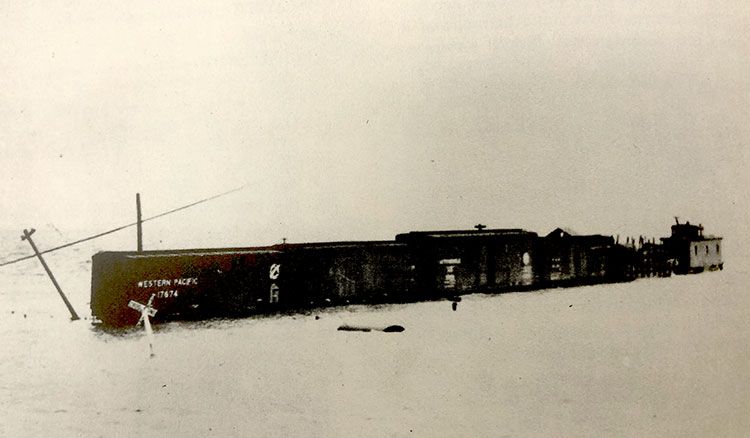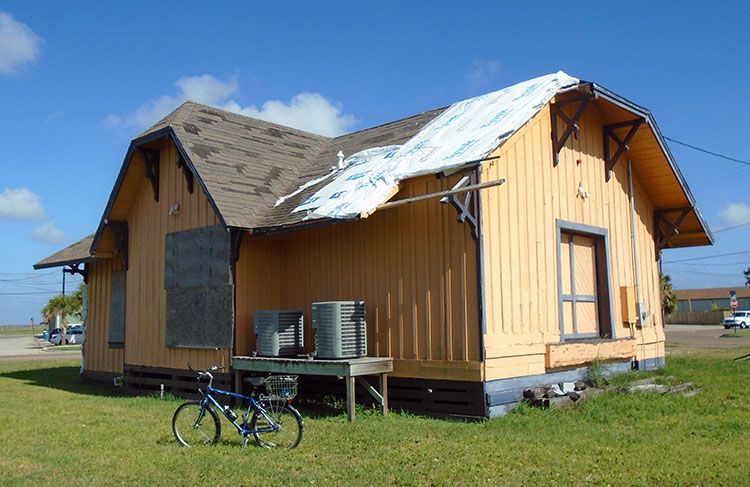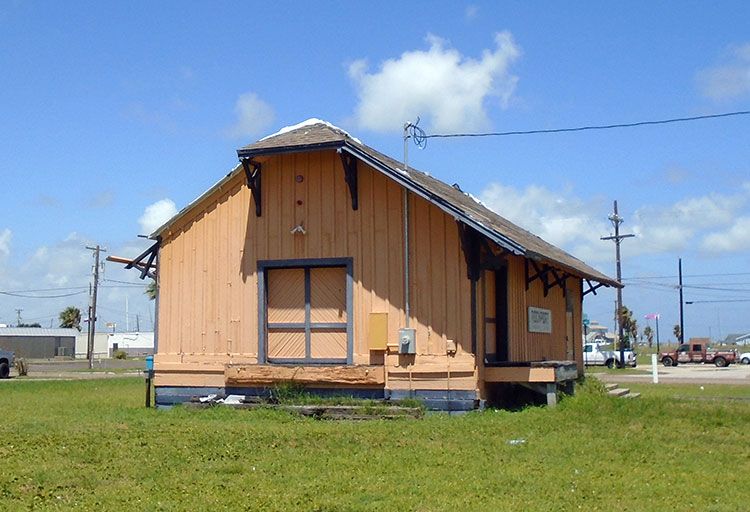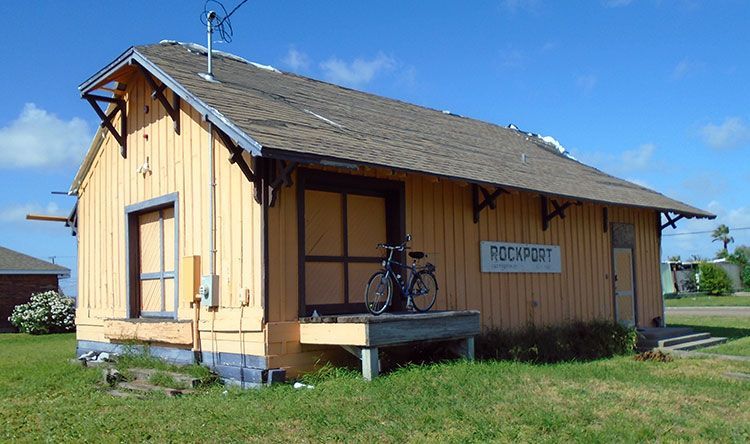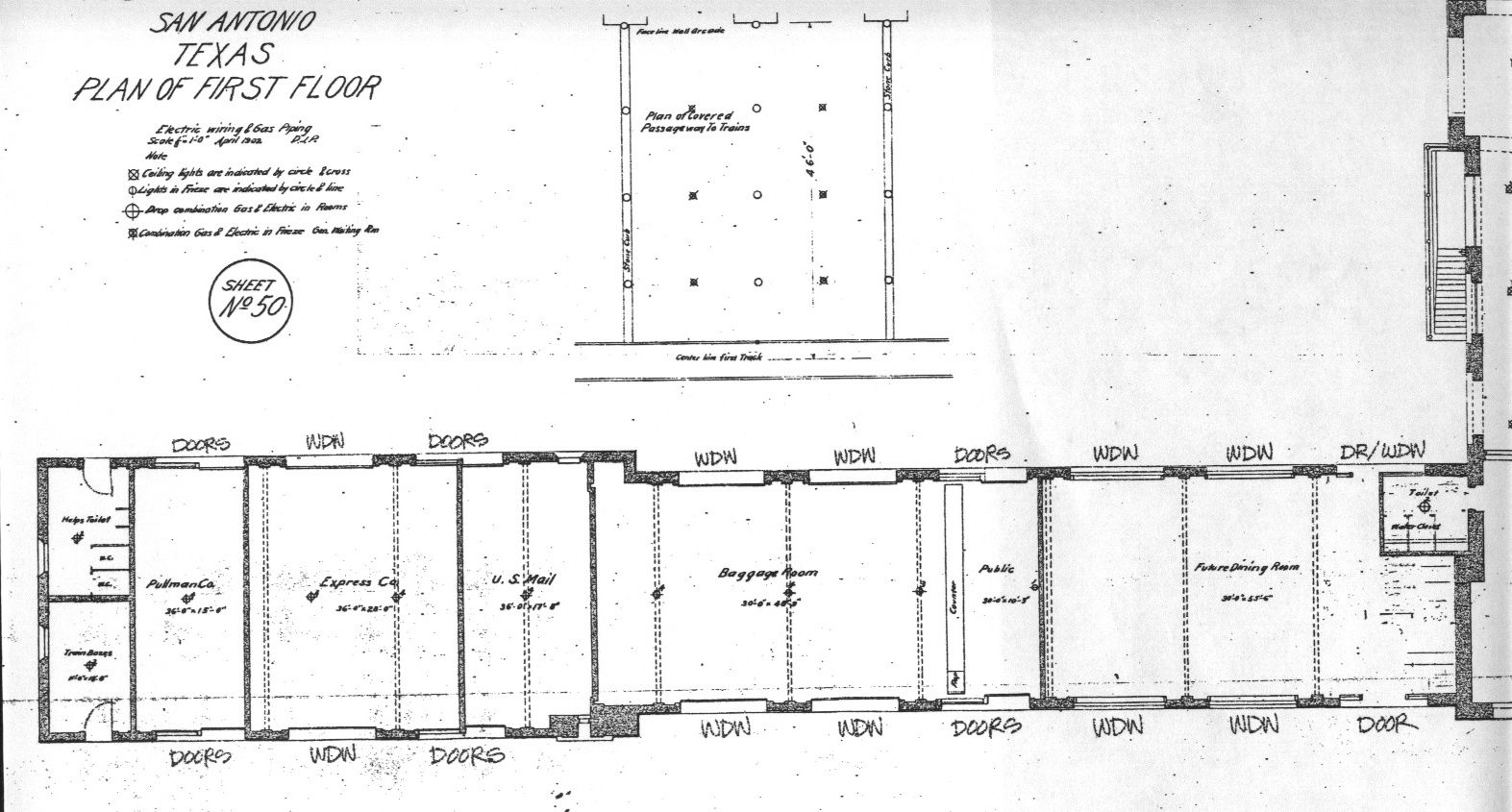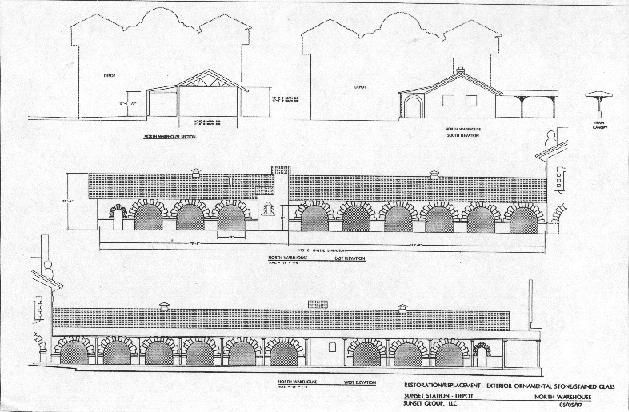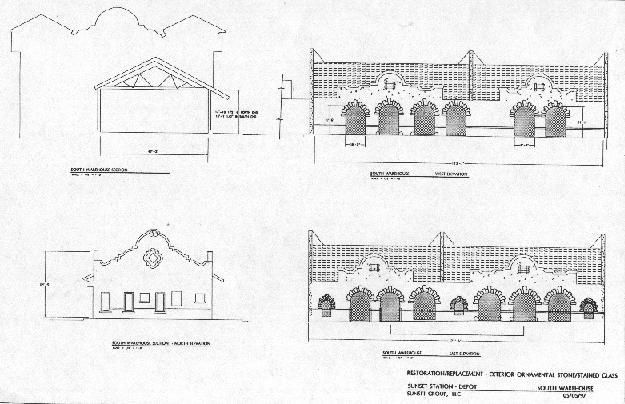The Railroad in Rockport, Texas
This page was created with the generous help of several organizations and individuals.
The Aransas County History Center
The Aransas County History Society, expecially Janie White
The Aransas County Public Libaray, located in Rockport
The Rockport Cultural Arts Disitrict, expecially its Exective Director, Jennifer Day.
The Fulton Mansion History Center, especially Christi Morgan
The "Texas Railroad History" Facebook group page, expecially
Chino Chapa, John Sniffen and Stuart Schroeder.
The San Antonio & Aransas Pass railroad was formed in 1884 by San Antonio business leaders who felt that the city was not being served well by the California based Southern Pacific which was focused on moving freight between New Orleans and Galveston to California. The SP, operating as the Texas & New Orleans (T&NO) RR in Texas, was, in their opinion, little interested in serving cities along their transcontinental route. Enjoying a monopoly, the SP charged high rates and could pick and choose customers to best suit themselves. While San Antonio businessmen wanted an alternative, there were no good options in the mid 1880s. However, many small communities along the Texas coast, but not much more than fishing villages, had ambitions to develop an alternative deep water port to Galveston, and it was felt that railroad service would help spur this development. Aransas Pass seemed like the best bet, so they named the company after this location.
Rockport Railroad branch line depots and tracks
The route the SA&AP adopted aimed towards Aransas Bay. However, the small independent railroad was very poorly funded. After it scraped up enough resources to reach Floresville, then a tiny community of no consequence, it completely ran out of money. Fortunately the SA&AP's main promoter and engineer, Uriah Lott, had previously built a line with equally meager resources, and prospects, from Laredo to Corpus Christi for Mifflin Kenedy and it turned out to be a great success, so Kenedy was willing - for a share of future construction bonuses and profits, to bankroll construction - not to Aransas Pass but Corpus Christi, closer to his own base of operations, which was mainly ranching. Construction was swift. After the tracks reached the small town of Gregory they turned south towards Corpus Christi. To get there, causeways over long stretches of tidal seawater had to be constructed, but it worked and the line reached Corpus Christi in 1886.
Rockport Railroad branch line maps
This was very disappointing to residents along the Aransas Bay area, who were equally ambitious to experience the growth that railroad service would bring, They had experienced a boom and bust cycle already and relying on shipping for trade was becoming increasingly difficult, as the SP had purchased the major company, Morgan Shipping Lines, and had withdrawn the ships to maintain their focus on Galveston, where the SP had laid its bets. Major Aransas County ranch land owners Thomas Coleman and George Fulton approached the SA&AP and negotiated for a branch line from Gregory to be constructed, allowing for free right of way over their vast holdings and the provision of lots for the creation of several towns. On July 15, 1888, the branch line reached Rockport, which had been founded in 1870 after the first pier had been built three years earlier. In 1891 an extension through the new community of Fulton was constructed, to a place called Oceanview. Hopes for a town complete with a large tourist hotel failed to materialize and the extension was removed in 1894, though to this day there is a street in Fulton called railroad Avenue. After 1894, the tracks ended at the 21 mile mark in the heart of Rockport, extending beyond the depot onto a pier over the water.
Timetables showing railroad service to the Rockport depot
After the San Antonio and Aransas Pass railroad reached Rockport in 1888, two years after it had begun service to Corpus Christi, the effect on the town was immediate. The population jumped from 600 to 2,500 in just two years. Initially there was only one passenger train a day in each direction on the branch line between Rockport and Gregory, but the main purpose was moving freight. The area's first main product was beef cattle but soon fishing, shrimping and boat building became every bit as important. The tracks went past the depot which was about a block away from the shoreline, all the way onto a pier over the water. Tourism also became very important. A number of grand hotels were constructed with easy access to the fine sandy beaches on the bay. Rockport became a desirable destination for many wealthy patrons. The San Antonio Express newspaper sponsored an annual regatta that attracted many visitors. Hotels vied with each other for grand evening balls with the best musicians. Within a decade, passenger traffic demand allowed for the addition of a second passenger train in each direction.
Rail service was integral to the growth and vitality of communities along the Aransas Bay in this era. As well as serving all the major industries, the railroad brought in all the other goods and services, including the mail, newspapers, fresh food, and everything you might find in department and other types of stores. They also delivered fuel, such as gasoline and coal. A major lumber yard owned by Charles Johnson had its own spur. Another product that was very popular was alcohol. Beer at this time was still live in the bottle and would go bad just as fast as milk. Delivering it in refrigerated rail cars was most appreciated everywhere the railroads went. Passenger travel had its value as well, of course. Tourism became a major economic activity. Initially there was one passenger train a day from Rockport, leaving for Gregory, where the branch line connected with the main line, early in the morning, and returning in the late evening. To reach San Antonio in 1893, you'd leave Rockport at 6:25 AM, change train at Gregory, and reach San Antonio around 1:45 PM. In 1903 the same service ran about 30 minutes later. It was still the same in 1918, but by this time there was a second train to Gregory as well. This left at 1:15 PM. However, there was no train to San Antonio at this time, but it did allow passengers to go to Corpus Christi within a reasonable time frame. Initially Corpus Christi also only had one passenger train each way a day, and you'd have had to wait until the evening train. You wouldn't arrive in Corpus Christi until 8:25 PM, a full 14 hours after leaving Rockport. With the second train leaving Rockport at 1:15 PM, and another wait in Gregory, you'd arrive in Corpus Christi by 3:15 PM, not bad for those days.
Rockport after two hurricanes almost a century apart
Rockport Railroad depot in 2017 and 2020
As time passed, more transportation options emerged. Better cars and roads, complete with bridges allowed for both automobiles and buses to take over the transportation of people. When a new, more direct, rail service was built from Corpus Christi to San Antonio in 1914 - ironically paid for by Corpus Christi businessmen who felt that the Southern Pacific was treating them very poorly - the SP downgraded all of the old SA&AP., which it had been in control of since the mid-1890s, to secondary status. When the deep water port at Corpus Christi, created with federal assistance in 1925, was further deepened and widened in the late 1950s, a new high bridge was built. (It opened in 1959 and is itself about to be replaced.)- At the same time, the old swing-up bascule bridge the railroad - and main road - used to cross the formerly narrow water way was removed, access to the SP’s remaining freight yard was lost. Seeing little purpose in investing into a port they did not value, the SP abandoned service to Corpus Christi completely. Passenger service on the old SA&AP system had ended much earlier, in the late 1940s but freight rail service to Gregory and beyond continued, mainly serving a number of petro-chemical facilities built along the coast. However, even this became unprofitable, and the branch line from Gregory to Rockport was removed in 1985.
The Future of Rockport Railroad depot
Happily, the original 1888 railroad depot in Rockport still stands. After serving the railroad until 1985 – and being modified over time to best suit current needs - the building was sold to a local buyer. Until recently it was owned by a Rockport artist. Its continued existence is all the more remarkable in that it has survived not one but two devastating hurricanes, in 1919 and again in 2017. In the latter, it suffered significant damage, but was built so well that it still has complete structural integrity and is eminently restorable. By comparison both the old county court house and city hall were destroyed by Hurricane Harvey in 2017 and are being replaced with new buildings. Suffering a similar fate was the old tin-sided freight building close to the depot. It was not original to 1888. A smaller structure owned and operated by Wells Fargo as an express freight depot used to be in that area. Nowhere near as sturdily built, the large freight shed was lost to the storm. But as for the depot, its future seems bright. Arrangements are being made for it and the land it occupies to be donated.. The goal is to restore back it to its original appearance and make it a focal point within the historic district that has helped to save the earlier charm and ambiance of this renowned community. The depot will be used by both local groups as a meeting space and also open to the public. A new hike and bike trail being developed will follow some of the route of the old tracks, a fine tribute to the impact that the railroad had on the very much vibrant community of Rockport.
Transportation Museum
CONTACT US TODAY
Phone:
210-490-3554 (Only on Weekends)
Email:
info@txtm.org
Physical Address
11731 Wetmore Rd.
San Antonio TX 78247
Please Contact Us for Our Mailing Address
All Rights Reserved | Texas Transportation Museum
